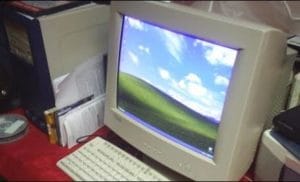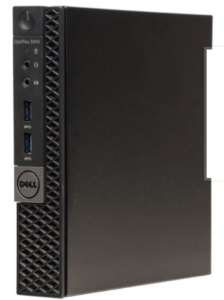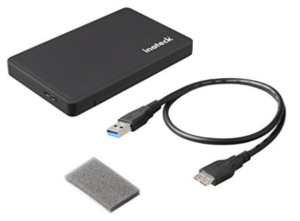Between Laptop and Desktop
 Between Laptop and Desktop: a reader asks…
Between Laptop and Desktop: a reader asks…
Hi Chris, I need a new computer, my old one is a behemoth HP desktop PC with Windows Vista and an old-style CRT monitor. I don’t really need a laptop, but would like something smaller yet capable and fast. My budget is to keep it well under $1,000 all-in. I’m reasonably handy and can do the setup myself. What would you suggest?
For many folks, an all-in-one computer can be a great replacement. Basically, you get a larg(er) flat-screen that has the guts of a PC built into the backside. Lenovo makes two nice models, a 23″ for about $600-700 and a 27″ for about $900-1,000. They come with a keyboard and mouse, and have built-in speakers, so you really don’t need anything else (assuming your printer is still working). The only drawback is that most parts inside are engineered to fit in the system and the system case may not be easy to disassemble. So if you need repairs or want to upgrade your hard drive (to an SSD), it can be a bit of work.
 I have an alternative solution for you that you might find attractive. Shopping at Microcenter.com (online or in-person), you can buy everything you need. These days a CD/DVD drive is often superfluous, and without that you can go for a small form-factor PC with all the power of a regular desktop PC in little more space than a clock-radio. And if you don’t mind a certified refurbished CPU, you can save a lot of money.
I have an alternative solution for you that you might find attractive. Shopping at Microcenter.com (online or in-person), you can buy everything you need. These days a CD/DVD drive is often superfluous, and without that you can go for a small form-factor PC with all the power of a regular desktop PC in little more space than a clock-radio. And if you don’t mind a certified refurbished CPU, you can save a lot of money.
I’m talking about a CPU that’s only 7″ wide by 7″ deep and 1.5″ tall. This is the Dell Optiplex 3040 Micro Desktop, and Microcenter has several refurbished models for $380. They have two models (same price) either with or without Wi-Fi. It comes with a standard wired keyboard and mouse, and the CPU has a built-in speaker (not stereo, but ok for simple audio needs), and jacks for a microphone or headphones or external speakers, along with USB 3.0 ports on the front and back. It’s powerful enough to drive two display monitors if you want.
To that you could add a Dell 24″ monitor for $200 (and get a Displayport cable for about $11), and you’ve got yourself a great desktop PC using a fraction of the space of your old one.

 If you’d like to really boost the speed, you can replace the 500gb spinning hard drive that’s included with a speedy Solid-state drive (SSD). You can get the SanDisk 480gb SSD for only $120. You’ll need some software and a connector to clone the hard drive, I like Paragon’s OS to SSD software, and you can get a SATA to USB cable for about $12 (or less) at Amazon. There are kits you can buy that have both cable and software, but I’ve found the software to be buggy. Paragon’s software is rock-solid.
If you’d like to really boost the speed, you can replace the 500gb spinning hard drive that’s included with a speedy Solid-state drive (SSD). You can get the SanDisk 480gb SSD for only $120. You’ll need some software and a connector to clone the hard drive, I like Paragon’s OS to SSD software, and you can get a SATA to USB cable for about $12 (or less) at Amazon. There are kits you can buy that have both cable and software, but I’ve found the software to be buggy. Paragon’s software is rock-solid.
Alternatively, you can get a hard drive enclosure and turn the original hard drive into a backup drive. There’s a nice one at Amazon.com for $10 (you still need the Paragon software). While this option is actually cheaper than the SATA to USB cable noted above, these external hard drive enclosures have more parts so are more prone to breaking than a simple cable. Less is more and more is less…
So here’s your hardware shopping list for Microcenter:
- Displayport cable $11 http://www.microcenter.com/product/396852/3ft_DisplayPort_Digital_A-V_Cable_with_Latches
- Dell Optiplex $380 http://www.microcenter.com/product/470866/OptiPlex_3040_Micro_Desktop_Computer_Refurbished
- Dell 24” monitor $200 http://www.microcenter.com/product/464859/P2417H_24_IPS_LED_Monitor
- SanDisk 480gb SSD $120 http://www.microcenter.com/product/465262/480GB_SSD_Plus
That will run you about $711, plus the cost of the Paragon software and the cable. Get it all home and hook it up and press the power buttons. Create your user account on Windows 10 (64-bit Pro comes with the Optiplex), and finish setting up your computer (handy tips on my article New Laptop Setup). Make sure you get all the updates to Windows that’s available. You can choose to install your other software before or after you clone and replace the hard drive.
Cloning the hard drive and replacing it is very easy, no tools required. Install the software and plug the SSD into the adapter cable, and the adapter cable into a front USB 3.0 port. Run the Paragon software and follow the easy on-screen instructions, then go have a cuppa coffee – it’ll take a few hours.
When the cloning process is done, shut off the PC and unplug everything. there’s a thumbscrew on the back to loosen and slide the top off the Optiplex. the hard drive slides away from the connector, and slide the new SSD in its place. Replace the cover, tighten the thumbscrew and plug everything back in. Start up the computer and see how fast it boots up (and it’ll get faster after a few more restarts). More reliable too.

The original hard drive can be set aside somewhere for disaster recovery, or you can re-purpose it with an external hard drive enclosure. If you do re-purpose it, you’d insert the original hard drive in the enclosure, plug it into a USB 3.0 port on your micro PC, and then reformat the hard drive to erase the original contents and make the 500gb of space available for backup.
I’d suggest if you do this that you turn on File History (in Windows 10 on your micro PC), and point File History to save to the external hard drive (it will probably be labeled as the D drive).
Your new micro PC does not come with a CD/DVD drive, but there are plenty of slim drives that plug into USB ports you could use if you have such need of one. There is a Dell Optiplex 3040 model that includes an internal CD/DVD drive, but it’s quite a bit larger than the micro PC noted above. Also a lot more expensive, certainly more that the $35 or so that a slim external drive would cost you (such as this one: https://www.amazon.com/Asus-External-Slim-Drive-SDRW-08D2S-U/dp/B003YT578O).
Even if you add the bulk of an external CD/DVD drive and the external hard drive (for backup), you’re still working with a very tiny but powerful computing system that could sit behind the computer monitor and function pretty close to the same as a more expensive all-in-one system, but with a lot more power and speed.
This website runs on a patronage model. If you find my answers of value, please consider supporting me by sending any dollar amount via:
or by mailing a check/cash to PosiTek.net LLC 1934 Old Gallows Road, Suite 350, Tysons Corner VA 22182. I am not a non-profit, but your support helps me to continue delivering advice and consumer technology support to the public. Thanks!







Easy to follow, great advise and clearly described!!! Even I, a MAC user followed this 🙂
Thanks Tom, the Dell Optiplex is a PC answer to Apple’s Mac Mini, although I have to say the hard drive replacement process for the Mac Mini is orders of magnitude more complicated than the Optiplex.